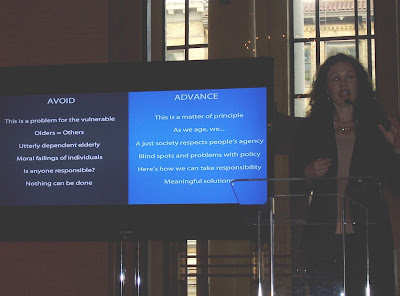This Chair Rocks: A Manifesto Against Ageism author Ashton Applewhite rocks, ever since I read her April 2015 post about starting
a campaign for Letting Our Hair Go Gray, and coloring her naturally brown hair a shade
of gray. During this experiment, she
concluded “gray hair + confidence is an empowering and liberating combo. I hope to see more people rocking the look ...”
"Love means never
having to say you’re sorry" about gray hair … At age 75 (in 2014), actress and style icon Ali MacGraw finally embraced gray hair (to match her natural eyebrows!), after being surrounded by “grown-up women” in
her hometown of Santa Fe—away from the superficiality of la-la land. Glamour magazine reported celebrities of all
ages who also rocked the granny hair vogue.
Esquire featured “The Men Who Rock Silver Hair Right." According to San Francisco Chronicle, it’s never too young to go gray. The New York Times noted, “For Millennial Men, Gray Hair is Welcome” in the tradition of artist Andy Warhol who dyed his hair gray in his early 20s.
Instead
of being trendy, I prefer low-maintenance so I just let nature take its course
with my graying head of hair (plus wrinkles). Going gray is a natural process,
starting at age 30 for men and age 35 for women, though years later for Asians
and African-Americans. However, I don’t
know about going out in public with lady whiskers,
sported by a few of my shut-in clients, and high-maintenance removal techniques ... I suppose it depends on whether lady whiskers draw unwanted attention or
allow one to pass as a man with privileges?
Ashton
showed up with mostly brown hair for her presentation, This Chair Rocks: An Evening with Activist Author Ashton Applewhite,
at Institute on Aging (IOA). She stated
her age 64, because ageism is reinforced by hiding one’s age. However, I prefer to be person-first and age-less, like comedian
Jerry Seinfeld’s remark about his former teenage girlfriend “is a person, not an age."
Ashton
was preaching to the choir of primarily older adults, mostly women, reminding
us that all aging is successful until we’re dead; the sum of our experiences make us rich; losses are real, so we need
friends of all ages and social connections, etc. Her call to action was to start a
consciousness-raising group, inviting us to check out her how-to booklet, “Who me, ageist?”
Fortunately,
aging anxiety drops with maturity as priorities change with age so older women
focus more on function than appearance of their bodies.
“I’ve spent an awful lot of time
worrying about looking old, and I’m ready to give it a rest. … I want the world
to recognize the beauty of time on a woman’s face, and if the world never will,
I want, at least, to make peace with it in my own life. I want to be like one
of those confident older women…wrinkles, gray hair, and all. …
Lately I’ve been thinking more about how to avoid
the things I’m actually scared of about getting old: becoming set in my ways,
stuck in my thinking or narrow in my influences. I want to keep my mind-set
open, my life full of voices that are vibrant and diverse. That takes a lot of
work too, but I’m confident it will have a greater return on investment than
all the creams in the world. That was always the case, it just took me getting
older to recognize it.” --Stella Bugbee, “Can Age-Shaming Be the Next Fat-Shaming?”, New York magazine
According
to Global GfK study (October 2016),
the top 5 physical concerns around aging
are:
- eyesight
getting poorer
- not
being as mentally alert /memory loss
- lacking
energy
- having
trouble taking care of themselves physically
- losing
mobility / being unable to walk or drive
But there are key differences by country: Russia is the only country surveyed where
“losing your teeth” is a top 5 concern, while China South Korea included “gaining weight” (as did USA
Timeless fashion
Timeless fashion
Kimono: Shades of IOA fashion
show featured IOA staff modeling the work of 18 On Lok Lifeways participants who hand painted garments created as part of their care plans.
Model shows kimono
print of dragon in front, clock in back symbolizing late bloomer. Expressive art therapist Tandrika Mayweather discussed
value and benefits of the project: strengthening hand and eye coordination, gross and fine motor skills, use of imagery and symbolism (right brain) until
language regained (left brain goes offline in trauma), and restoration as time
slips away while in the zone of creative expression.
Understanding Alzheimer’s disease
Understanding Alzheimer’s disease
Alzheimer’s Foundation of America (AFA) celebrated its 15th year with AFA Educating America
AFA President
Charles Fuschillo shared the stage with Dillon Campbell, son of musician Glen Campbell, who was commended for going public with diagnosis of AD to create more awareness
and understanding towards a cure. Dillon mentioned that his father treated AD with CBD from marijuana while living
in Malibu , now “checked out” but physically
strong in assisted living facility in Nashville
Moira O’Neill,
Director of Interpretation and Senior Researcher at FrameWorks Institute,
discussed challenges in framing (how to communicate about) aging and how to advance understanding:
- fatalistic (incurable) à
ingenuity (serious problem, but resourceful in providing solution)
- paternalistic (objects of care, charity response) à justice (collective responsibility, systemic change)
- private trouble (individual choice, family
responsibility) à support structures (everyone safe inside)
AFA conference also included The Hardest Crossword exercise, caregiver panel, free memory screenings, Quilt to Remember displays and resource tables. Conference ended
with The Beatles song, “In My Life,” which made me think about Life Story Work to enhance person-centered care for people with dementia.
Lifelong advocacy
“Refreshments
served” was more like a complete dinner at Rhoda Goldman Plaza , host site for this
month’s At Home With Growing Older (AHWGO) forum, Advocate!
Candiece
Milford, Managing Director of Marketing at Rhoda Goldman
Plaza Rhoda
Goldman Plaza
Speaker Barbara Kate Repa shared her 30 years of lifelong advocacy starting as a Nolo Press
author of books on estate planning and end-of-life, member of Bay Area Funeral
Society, and then volunteer with San Francisco Long-Term Care (LTC) Ombudsman (advocating for residents in LTC facilities; see this month’s CNN nursing home sex abuse investigative report)
and IOA Friendship Line (10-minute phone calls). She mentioned reverse
ageism when older callers might question the credibility of younger volunteers,
who are often students. After all, book
learning is no substitute for real world experiences to impart perspective, wisdom
and perhaps peer support.
Sheila
Malkind mentioned her advocacy work with Legacy Film Festival on Aging (showcasing more honest representations of the aging experience) and Older Women’s League.
AHWGO
Board member Cathy Spensley’s advocacy work includes Aging and Disability Friendly SF and geriatric mental health at Felton Institute. Cathy recommended signing up for Marie Jobling's monthly Community Living Campaign e-newsletter packed with aging and disability advocacy opportunities!
Seated behind Cathy is Odile Lavault, Jewish Home recreational therapist and advocate of Naomi Feil’s Validation Method.
Seated behind Cathy is Odile Lavault, Jewish Home recreational therapist and advocate of Naomi Feil’s Validation Method.
“Gray hair is a crown of beauty when it is found in
the way of righteousness.”--Proverbs 16:31













